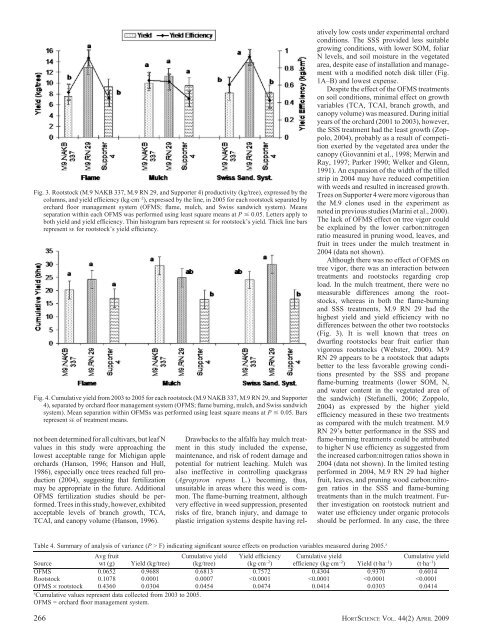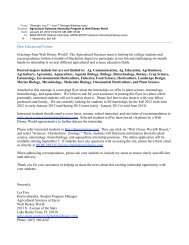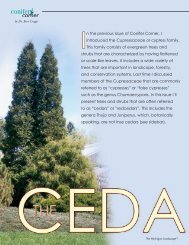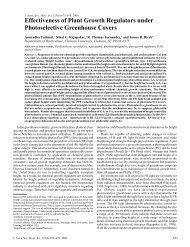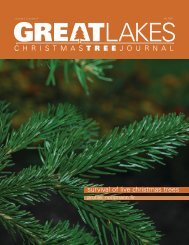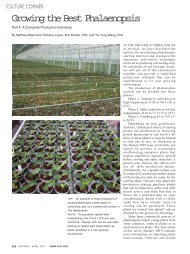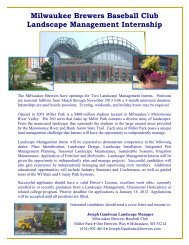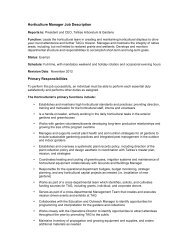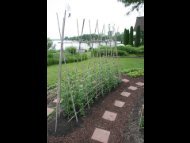Dario Stefanelli - HortScience
Dario Stefanelli - HortScience
Dario Stefanelli - HortScience
Create successful ePaper yourself
Turn your PDF publications into a flip-book with our unique Google optimized e-Paper software.
Fig. 3. Rootstock (M.9 NAKB 337, M.9 RN 29, and Supporter 4) productivity (kg/tree), expressed by the<br />
columns, and yield efficiency (kgcm –2 ), expressed by the line, in 2005 for each rootstock separated by<br />
orchard floor management system (OFMS; flame, mulch, and Swiss sandwich system). Means<br />
separation within each OFMS was performed using least square means at P # 0.05. Letters apply to<br />
both yield and yield efficiency. Thin histogram bars represent SE for rootstock’s yield. Thick line bars<br />
represent SE for rootstock’s yield efficiency.<br />
Fig. 4. Cumulative yield from 2003 to 2005 for each rootstock (M.9 NAKB 337, M.9 RN 29, and Supporter<br />
4), separated by orchard floor management system (OFMS; flame burning, mulch, and Swiss sandwich<br />
system). Mean separation within OFMSs was performed using least square means at P # 0.05. Bars<br />
represent SE of treatment means.<br />
not been determined for all cultivars, but leaf N<br />
values in this study were approaching the<br />
lowest acceptable range for Michigan apple<br />
orchards (Hanson, 1996; Hanson and Hull,<br />
1986), especially once trees reached full production<br />
(2004), suggesting that fertilization<br />
may be appropriate in the future. Additional<br />
OFMS fertilization studies should be performed.<br />
Trees in this study, however, exhibited<br />
acceptable levels of branch growth, TCA,<br />
TCAI, and canopy volume (Hanson, 1996).<br />
Drawbacks to the alfalfa hay mulch treatment<br />
in this study included the expense,<br />
maintenance, and risk of rodent damage and<br />
potential for nutrient leaching. Mulch was<br />
also ineffective in controlling quackgrass<br />
(Agropyron repens L.) becoming, thus,<br />
unsuitable in areas where this weed is common.<br />
The flame-burning treatment, although<br />
very effective in weed suppression, presented<br />
risks of fire, branch injury, and damage to<br />
plastic irrigation systems despite having relatively<br />
low costs under experimental orchard<br />
conditions. The SSS provided less suitable<br />
growing conditions, with lower SOM, foliar<br />
N levels, and soil moisture in the vegetated<br />
area, despite ease of installation and management<br />
with a modified notch disk tiller (Fig.<br />
1A–B) and lowest expense.<br />
Despite the effect of the OFMS treatments<br />
on soil conditions, minimal effect on growth<br />
variables (TCA, TCAI, branch growth, and<br />
canopy volume) was measured. During initial<br />
years of the orchard (2001 to 2003), however,<br />
the SSS treatment had the least growth (Zoppolo,<br />
2004), probably as a result of competition<br />
exerted by the vegetated area under the<br />
canopy (Giovannini et al., 1998; Merwin and<br />
Ray, 1997; Parker 1990; Welker and Glenn,<br />
1991). An expansion of the width of the tilled<br />
strip in 2004 may have reduced competition<br />
with weeds and resulted in increased growth.<br />
Trees on Supporter 4 were more vigorous than<br />
the M.9 clones used in the experiment as<br />
noted in previous studies (Marini et al., 2000).<br />
The lack of OFMS effect on tree vigor could<br />
be explained by the lower carbon:nitrogen<br />
ratio measured in pruning wood, leaves, and<br />
fruit in trees under the mulch treatment in<br />
2004 (data not shown).<br />
Although there was no effect of OFMS on<br />
tree vigor, there was an interaction between<br />
treatments and rootstocks regarding crop<br />
load. In the mulch treatment, there were no<br />
measurable differences among the rootstocks,<br />
whereas in both the flame-burning<br />
and SSS treatments, M.9 RN 29 had the<br />
highest yield and yield efficiency with no<br />
differences between the other two rootstocks<br />
(Fig. 3). It is well known that trees on<br />
dwarfing rootstocks bear fruit earlier than<br />
vigorous rootstocks (Webster, 2000). M.9<br />
RN 29 appears to be a rootstock that adapts<br />
better to the less favorable growing conditions<br />
presented by the SSS and propane<br />
flame-burning treatments (lower SOM, N,<br />
and water content in the vegetated area of<br />
the sandwich) (<strong>Stefanelli</strong>, 2006; Zoppolo,<br />
2004) as expressed by the higher yield<br />
efficiency measured in these two treatments<br />
as compared with the mulch treatment. M.9<br />
RN 29’s better performance in the SSS and<br />
flame-burning treatments could be attributed<br />
to higher N use efficiency as suggested from<br />
the increased carbon:nitrogen ratios shown in<br />
2004 (data not shown). In the limited testing<br />
performed in 2004, M.9 RN 29 had higher<br />
fruit, leaves, and pruning wood carbon:nitrogen<br />
ratios in the SSS and flame-burning<br />
treatments than in the mulch treatment. Further<br />
investigation on rootstock nutrient and<br />
water use efficiency under organic protocols<br />
should be performed. In any case, the three<br />
Table 4. Summary of analysis of variance (P > F) indicating significant source effects on production variables measured during 2005. z<br />
Source<br />
Avg fruit<br />
wt (g) Yield (kg/tree)<br />
Cumulative yield<br />
(kg/tree)<br />
Yield efficiency<br />
(kgcm –2 )<br />
Cumulative yield<br />
efficiency (kgcm –2 ) Yield (tha –1 )<br />
Cumulative yield<br />
(tha –1 )<br />
OFMS 0.0652 0.9688 0.6813 0.7572 0.4304 0.9370 0.6014<br />
Rootstock 0.1078 0.0001 0.0007


